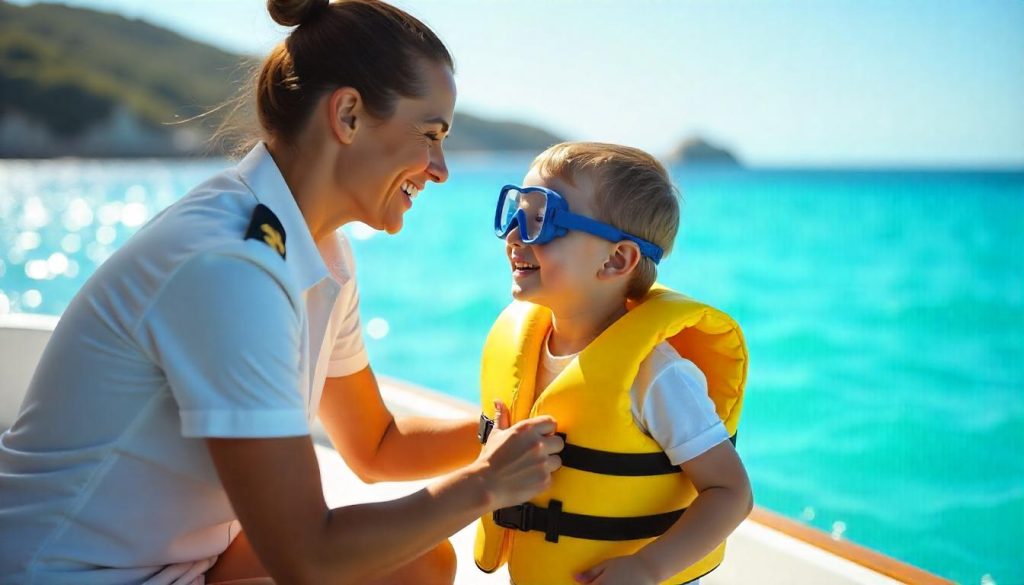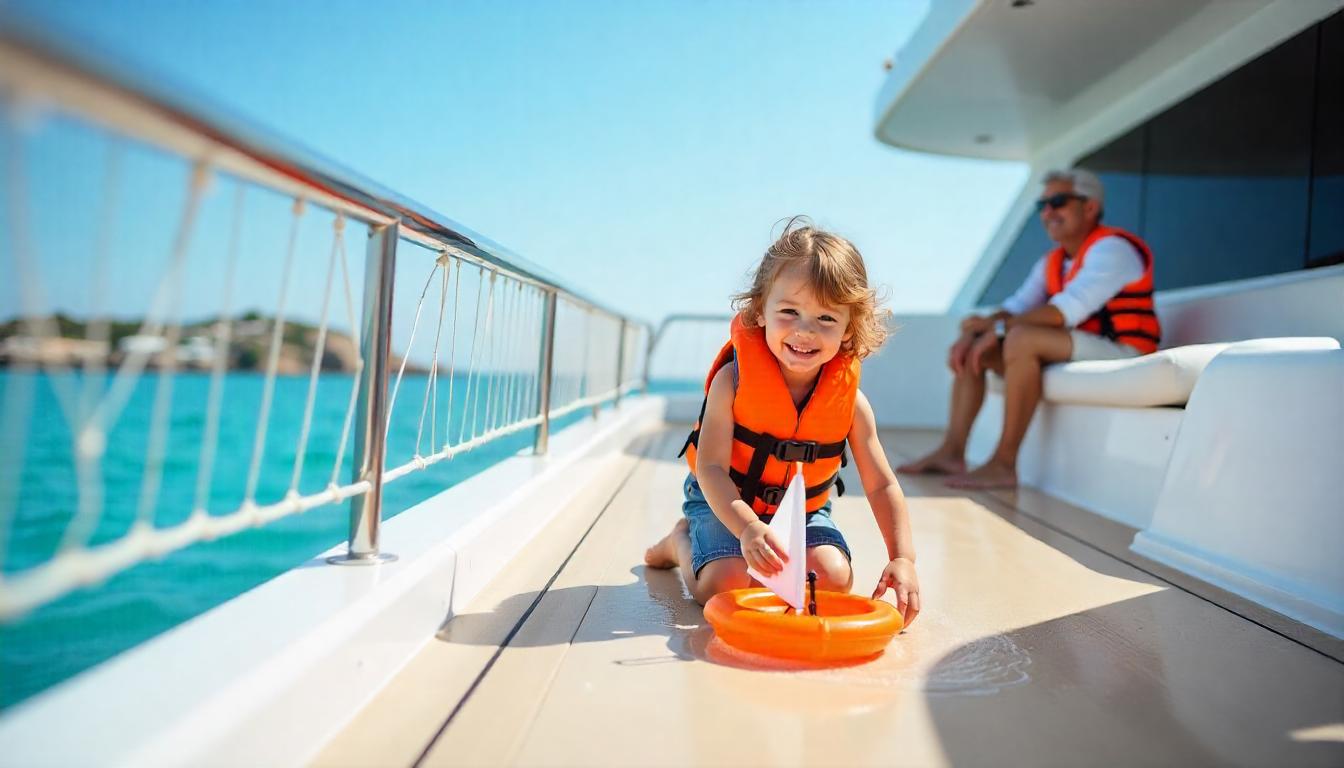A yacht charter offers an unparalleled family vacation, promising adventure, discovery, and priceless bonding time on the open water. Imagine days filled with swimming in secluded coves, exploring vibrant marine life, and evenings spent under a canopy of stars. However, for parents, the thought of children on a moving vessel surrounded by water can bring understandable safety concerns. The good news is that with careful planning and the right precautions, you can ensure your yacht trip is not only incredibly fun but also completely safe for children of all ages. Making your charter a child-safe yacht charter is entirely achievable. For families planning an unforgettable escape from a landlocked location like Aktobe, understanding these safety measures is key to enjoying a truly worry-free marine adventure.
1. Choosing the Right Yacht for Your Family-Friendly Yacht Charter
The foundation of a safe charter begins with selecting a yacht that is inherently suited for children. Not all vessels are created equal when it comes to family safety features.
Railings, Netting, and Secure Decks
The first and most critical safety feature to evaluate is the yacht’s perimeter. Look for vessels with high, sturdy railings that are difficult for small children to climb over or slip through. In addition, many charter companies can install custom safety netting along the entire length of the railings, creating an impenetrable barrier. This netting is particularly vital for toddlers and very young children, offering invaluable peace of mind. Moreover, assess the deck surfaces. Non-slip materials are essential to prevent falls, especially when the decks are wet. Ensure there are minimal tripping hazards and that all deck hatches are securely latched.
Cabin Layouts and Child-Friendly Spaces
Consider the internal layout of the yacht. Are cabins well-suited for families? Some yachts offer bunk beds, while others may have flexible sleeping arrangements. Ideally, cabins should have secure doors and minimal sharp corners or edges within reach of little ones. Furthermore, look for yachts with common areas that allow children to play safely under supervision. A large saloon or an enclosed aft deck can provide a perfect space for games and relaxation, away from the risks of open railings or moving parts.
Stability and Motion Sickness Considerations
The stability of a yacht can significantly impact a child’s comfort and safety. Catamarans, with their dual hulls, generally offer greater stability than monohulls, which can be advantageous for children prone to seasickness. A more stable platform reduces the likelihood of falls on deck. Furthermore, many larger yachts are equipped with stabilizers (both at anchor and underway) that dramatically reduce rolling motion, enhancing comfort for everyone, especially young passengers. Discuss these options with your charter broker to select the most suitable vessel for your family’s needs.
2. Essential Safety Gear for Children Onboard
Beyond the yacht’s inherent features, personal safety gear is non-negotiable for all children on a charter.
Properly Fitted Life Jackets
Every child on board must have a properly fitted life jacket. This is arguably the most crucial piece of safety equipment. Do not rely solely on the yacht’s provided jackets; bring your children’s own, as you will know they fit correctly and are comfortable. Life jackets should be Coast Guard or equivalent certified, and designed for their weight and age. For infants, special life jackets with head support are available. Insist that children wear their life jackets whenever they are on deck, particularly when the yacht is underway, during tender transfers, or when playing near the water.
Personal Flotation Devices (PFDs) for Water Activities
Beyond mandatory life jackets, consider additional personal flotation devices (PFDs) for specific water activities. These might include buoyancy aids for snorkeling or swimming, or specialized vests for water sports like paddleboarding or kayaking. While these are not substitutes for life jackets, they offer extra buoyancy and confidence in the water. Ensure they are brightly colored for easy visibility.
First-Aid Kits and Medical Preparedness
A comprehensive first-aid kit is essential on any yacht, but even more so with children onboard. Ensure it is well-stocked with supplies for minor cuts, scrapes, stings, and burns. Include children’s pain relievers, allergy medication, and any prescription medications your children may need. Communicate all medical conditions and allergies to the captain and crew well in advance. Consider bringing your own small, portable first-aid kit for shore excursions. Knowledge of basic first aid and CPR is also highly recommended for adults on board.
3. Crew Expertise and Child Supervision
The professionalism and experience of your crew are vital components of a child-safe yacht charter. They are your partners in ensuring a secure environment.
Vetting a Child-Experienced Crew
When booking your charter, specifically request a crew with experience working with children. A child-friendly crew will understand the unique needs of young guests, from preparing appropriate meals to engaging them in fun, safe activities. They can also assist with supervision, particularly during meal times or when parents need a break. Furthermore, crew members who are comfortable and experienced around children can act as an invaluable extra set of eyes, especially on a moving vessel.
Designated Supervision Zones and Rules
Work with the captain to establish clear supervision protocols. Decide which areas of the yacht require constant adult supervision (e.g., the bow, swim platform when in use, galley) and which areas are safer for more independent play. Communicate these zones and rules clearly to both children and all adults on board. A crew that understands and adheres to these supervision guidelines will greatly contribute to overall safety.
Emergency Drills and Communication
Before setting sail, insist on a comprehensive safety briefing. This should include the location of life jackets, emergency exits, and muster points. Practice a basic “man overboard” drill, explaining the procedure in a way children can understand. Ensure all adults know how to operate the yacht’s tender and basic communication equipment. Knowing that your crew is well-versed in emergency procedures will provide immense peace of mind.

4. Onboard Rules and Education for Kids Yachting Safety
Empowering children with knowledge and clear boundaries is a crucial aspect of promoting boat child safety.
Establishing Clear Boundaries and No-Go Zones
From the moment they step onboard, establish clear rules and “no-go zones” for children. This might include areas like the engine room, anchor locker, or certain parts of the bridge. Explain why these rules are in place – for their safety. Use consistent language and ensure all adults on the trip reinforce the same message. Visual cues, like temporary barriers or “off-limits” signs, can be helpful for younger children.
Understanding Basic Boat Rules
Teach children basic boat safety rules, such as always holding onto a handrail when moving around the yacht, especially when underway. Emphasize that running on deck is not allowed. Explain the importance of not touching ropes, lines, or equipment without an adult’s permission. For slightly older children, teach them about the “buddy system” when swimming or using water toys.
Engaging Children in Safety Practices
Make safety engaging rather than daunting. Involve older children in age-appropriate safety tasks, such as checking fender placement or helping to secure loose items before departure. This not only teaches them valuable skills but also fosters a sense of responsibility and awareness. You can even turn safety briefings into a fun “captain’s training” session, making them more receptive to learning.
5. Planning a Child-Friendly and Secure Yacht Trip for Children
The itinerary itself plays a significant role in ensuring a safe and enjoyable experience for younger guests.
Calm Waters and Sheltered Anchorages
Prioritize calm cruising grounds with sheltered bays and anchorages. Avoiding rough seas significantly reduces the risk of seasickness and discomfort for children, making the trip much more enjoyable for everyone. Research your chosen destination for areas known for calm, protected waters. This will also make water activities like swimming and snorkeling much safer and more accessible.
Age-Appropriate Activities and Shore Excursions
Tailor your activities to the children’s ages and interests. A family-friendly yacht charter should offer a balance of active fun and relaxation. For younger children, short shore excursions to sandy beaches or playgrounds might be ideal. Older children might enjoy snorkeling, paddleboarding, or exploring local marine life. Over-scheduling can lead to fatigue and grumpiness, so build in plenty of free play and downtime.
Flexible Schedules and Downtime
Children thrive on routine but also need flexibility. While it’s good to have a general plan, be prepared to adjust it based on their energy levels or unexpected discoveries. Build in ample downtime for naps, quiet play, or simply relaxing. A well-rested child is a happy child, and a happy child contributes to a stress-free environment for the adults.
Ultimately, a child-safe yacht charter is a magical way for families to connect and create lasting memories. By taking a proactive approach to safety—from selecting the right yacht and gear to establishing clear rules and relying on an experienced crew—you can ensure your maritime adventure is nothing short of perfect, allowing everyone, from the youngest to the oldest, to relax and fully embrace the joys of life at sea.

 How to Make Your Charter Child-Safe">
How to Make Your Charter Child-Safe">
